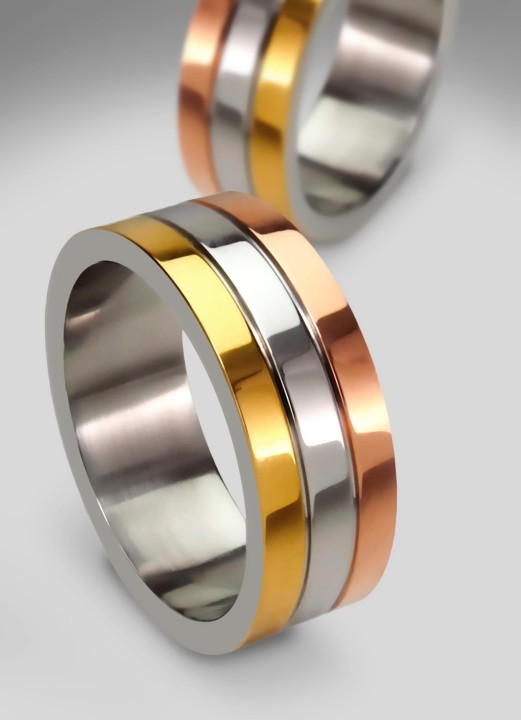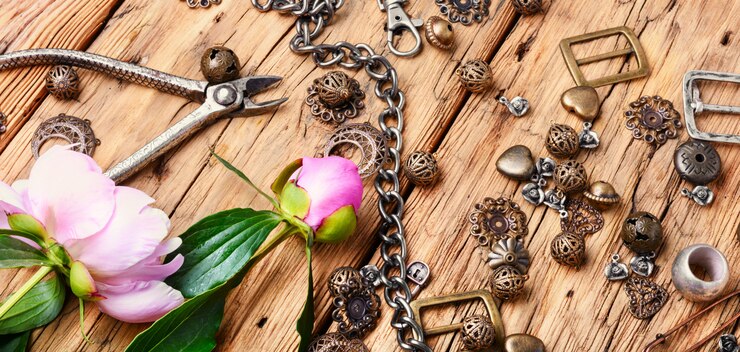Have you ever wondered what jewelry metals are used to make that beautiful necklace or those stunning earrings you’re wearing? This quick guide to jewelry metals and platings will help you understand the jewelry you have on, but also how to develop a private label jewelry brand of your own.
Types of Metals Used in Jewelry Manufacturing
From gold to silver to platinum, there are a variety of metals that can be used to create jewelry. Keep reading this quick guide to jewelry metals and platings to learn more!
Gold
Gold is one of the most popular metals used in jewelry making. It is a beautiful yellow metal that is ductile and malleable. Gold is also a very soft metal, which makes it easy to work with. However, because gold is so soft, it is not as durable as some other metals and it can scratch easily.
Silver
Silver is another popular choice for jewelry making. It is a white metal that is very ductile and very soft. Silver is also the best conductor of heat and electricity out of all the metals on this list. One downside of silver, however, is that it tarnishes easily when exposed to air and water.
Platinum
Platinum is a grayish-white metal that is very dense and very malleable. Platinum is also hypoallergenic, meaning that it will not cause an allergic reaction in people who are allergic to other metals like nickel. Platinum is a very expensive metal, which makes it less popular than gold and silver for mass-produced jewelry. However, platinum engagement rings are becoming more popular because they are more durable than gold rings and won’t tarnish like silver rings.
Palladium
Palladium is another grayish-white metal that is part of the platinum family. Palladium is less dense than platinum but just as malleable. Palladium is also hypoallergenic and does not tarnish like silver does. Palladium has a lower price point than platinum, making it a good alternative for people who want the look of platinum without the high price tag.
Titanium
Titanium metal has found many applications in the jewelry manufacturing industry, and is well-noted for its resistance to rust and corrosion. It is a strong, solid metal that’s considered to be lightweight and durable, suitable for everyday wear.
In fact, titanium is considered so safe to wear that it’s used in surgical applications because it’s a biocompatible metal. And because your body does not see biocompatible metals as foreign, it does not form a reaction against it, making it perfect for body piercings.
Titanium is used in a wide range of other jewelry including:
- engagement and wedding rings
- necklaces and pendants
- earrings and bracelets

What is Jewelry Plating?
Jewelry plating is the process of applying a thin layer of metal to the surface of another metal. This can be done for both aesthetic and functional purposes. For example, gold plating is often used to give a piece of jewelry a more luxurious look, while nickel plating can be used to protect the underlying metal from corrosion.
Types of Jewelry Platings and Their Applications
Gold Plating
Gold plating is just one of the many ways that gold is used to lend a luxurious air to an otherwise dull piece of jewelry. However, it’s also very popular for its anti-tarnish properties. Gold is a very inert metal, which means that it doesn’t react easily with other elements. This makes it ideal for protecting other metals from tarnishing.
Gold plating is usually applied to base metals such as copper, brass, or silver. It’s also possible to plate gold onto other metals such as titanium and stainless steel. The thickness of the gold layer is typically between 0.5 and 2 microns. When applied correctly, gold plating can last for many years without requiring touch-ups.
Silver Plating
Silver plating is similar to gold plating in that it’s used to give a piece of jewelry a more luxurious appearance. Silver is also very inert, so it has excellent anti-tarnish properties. Silver plating is typically applied to base metals such as copper and brass.
The thickness of the silver layer is usually between 0.5 and 2 microns. When applied correctly, silver plating can last for many years without requiring touch-ups.
Nickel Plating
Nickel plating is primarily used for its protective properties. Nickel is an extremely corrosion-resistant metal, so it’s often used as a coating on other less resistant metals such as steel or iron. Nickel plating can also be used to give a piece of jewelry a more polished appearance.
Nickel plating is usually applied to base metals such as iron or steel. The thickness of the nickel layer is typically between 5 and 10 microns. When applied correctly, nickel plating can last for many years without requiring touch-ups..
Rhodium Plating
Rhodium plating is similar to gold and silver plating in that it’s primarily used for its aesthetic properties. Rhodium is a precious metal that has a bright white colour and a high level of reflectivity.. Rhodium is also very inert, so it has excellent anti-tarnish properties.. Rhodium plating is typically applied to base metals such as copper, brass, or silver..
The thickness of the rhodium layer is usually between 0..5 and 2 microns.. When applied correctly rhodium plating can last for many years without requiring touch-ups..
LEARNING IN ACTION
As you can see, there are several different types of jewelry plating each with its own unique set of characteristics.. Choosing the right type of jewelry plating will depend on the desired outcome.. Whether you’re looking for aesthetics or functionality —or both— there’s sure to be plating that suits your needs!
Metals to Avoid in Jewelry Making
Despite how beautiful it may look, there are some metals that just won’t do when manufacturing fine jewelry. Reasons not to use these metals include toxicity and tarnishing. Let’s take a look:
What Jewelry Metals Are Toxic?
These metals can lead to major health problems when wearing them, when a child ingests them, or when you inhale fumes from the toxins contained in them.
- Arsenic is a chemical compound that occurs naturally. Although used extensively in car batteries, semi-conductors for electronic devices, pesticides, and ammunition, arsenic has been declared unsafe for human consumption or close contact use in all forms.
- Cadmium contains similar chemical compounds to zinc and mercury. Breathing in these fumes or ingesting pieces of jewelry can lead to a number of health risks according to the CDC. Cadmium deposits accumulate in nerves, the liver, and the kidneys. Extended exposure may therefore lead to brain fogginess, ongoing headaches, difficulty breathing, heart palpitations or chest pains, and death in extreme cases.
- Lead toxicity is responsible for liver and kidney damage, iron deficiency (anemia), fertility problems, pregnancy complications, and birth defects. Sudden exposure to lead may result in immediate death in some cases.
- Mercury poisoning is caused by a prolonged exposure to the metal. This has far-reaching health implications, such as disturbed nervous activity, upset digestive health, candida overgrowth in the gut, and mental retardation in extreme cases. Like lead, sudden exposure to large amounts of mercury may also result in sudden death.

What Jewelry Metals Tarnish Easily?
Costume or so-called fashion jewelry is inexpensive jewelry that is often made from low-quality materials and base metals. These metals include aluminum, brass, or copper, and may also include nickel and other inexpensive metals or substances.
As these metals are easily tarnished, they may need constant polishing and cleaning. The chemicals used to do this could cause skin irritations or allergic reactions in those sensitive to these chemical compounds.
How to Clean Fine Metals and Platings
There are a number of jewelry cleaner chemicals out there and I’m sure you already know which brand you prefer or can afford. Using these chemicals may very well clean your pieces of jewelry, but at what cost to your skin and health?
Rather, use the tried-and-tested methods discussed below to clean your jewelry metals and platings in a way that is not only more environmentally friendly, but less allergenic towards your sensitive skin.
LEARNING IN ACTION
Learning How to Make Your Own Jewelry
Get your online product business rolling. Enroll now for The Insider’s Guide to Private Label Jewelry – the affordable, easy-to-follow, and focused jewelry course that gets your designs onto paper and helps you find the perfect private label jewelry partner to make them.
BONUS MATERIAL!
Catch the Builders.Build podcast with my best friends, Colin and James, to discover more about our individual TikTok perspectives and entrepreneurial journeys across brands, products, websites, and more.
Thank you for reading this quick guide to jewelry metals and platings!
If you found this content insightful and helpful, please be sure to like and share this article with your circle. Also, make sure to subscribe to the newsletter for more product development tips!
– Oren







